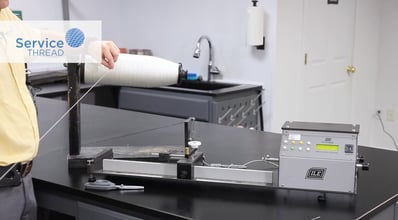Yarn twist is an important feature for many reasons – it binds fibers together and contributes to the strength of an industrial yarn. Twist contributes to a yarn's:
- strength
- elongation
- diameter
- torque
- luster & softness
- and more
It is essential to know the physical requirements for the yarn used in your product because unlike staple spun yarns, multifilament yarns can lose strength as the twist is increased. Additionally, elongation increases with increasing twist, as does diameter, torque and luster. Yarns become stiffer with twist therefore softness decreases.
Twist level can be measured in turns per inch (TPI) or turns per meter (TPM). In this video, a basic twist test procedure is demonstrated.
The Importance of Twist:

Twist is a very important characteristic of yarn for several reasons. Putting twist in yarn not only increases the strength of the material, but it can also reduce the footprint of the yarn (for example in a hose or in a cable). There are a couple of different ways that twist can be tested and it's all based on ASTM D1423. In this video, a twist test will be demonstrated in two different ways:
- Direct count method: Typically used for plied yarns
- Untwist/re-twist method: Used for single yarn and high twist yarns
Plied Yarn Twist Test
It's important to roll off the material you are testing to make sure that no twist is lost. If you pull the yarn off the nose of the package, you may add or remove a small amount of twist and get a false reading. Carefully secure the yarn in both clamps on the twist tester before cutting the yarn free from the package. The yarn clamps should be positioned so that you have a 10 inch specimen to test.
Using either a manual or automatic twist tester, slowly untwist the material until the plies are separated and a pick can pass from one end of the sample to the other. As the pick is passed between the plies, you may notice some residual twist. Continue untwisting the material until the pick can pass cleanly from one end of the sample to the other. Record the reading on the twist tester and repeat the process for additional samples.
Single Yarn Twist Test
Since the example used in the video is a cabled yarn, the three plies that were untwisted are also twisted in the opposite direction to give a more balanced thread. To check the twist in the individual ends after the first twist test is performed, trim away all excess ends, leaving the end you wish to test in the clamps. You may need to slightly adjust the positioning of the yarn to maintain the 10 inch sample length due to the yarn relaxing during the previous test. Single yarn ends are typically tested using the untwist and re-twist method as the filaments are entangled and the pick will never pass cleanly through from one end of the sample to the other.
To perform this test, note on the twist tester’s scale where the yarn position is before starting. Untwist the material until it is flat and the scale reaches its maximum point. Continue to twist in the same direction until the scale returns to its original point. This essentially puts the same amount of twist in the material as you originally had, but in the opposite direction. If you are using a manual machine, you will record the value and divide the number by two to determine the actual twist. Automatic machines may calculate the twist for you by untwisting the material flat and then re-twisting it in the same manner, using a sensor to mark the initial and stopping points on the scale.
Would you like to learn more about industrial multifilament yarns and the importance of twist? Please read our blog on this topic here.
Do you need help determining the right twist level for the yarns used in your application? Contact us to learn how Service Thread’s experienced materials specialists can help you improve the performance of your product.



